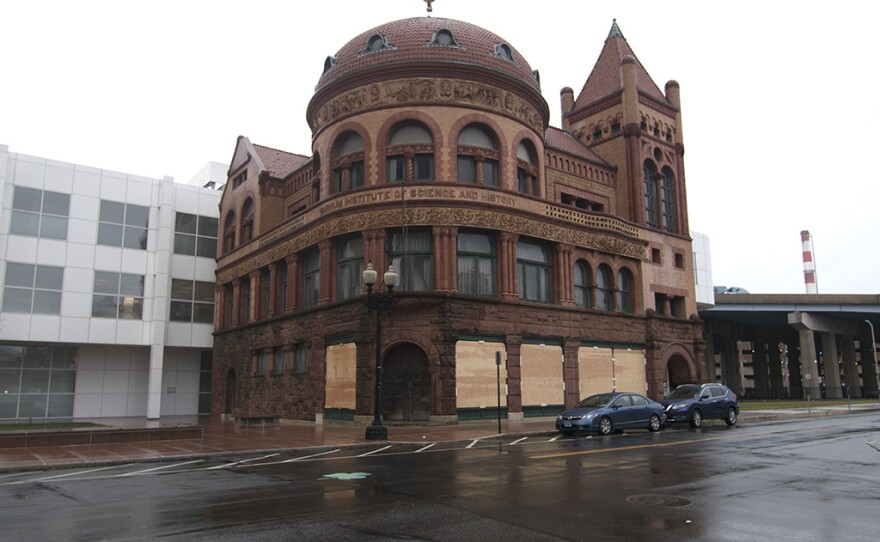The Ringling Bros. and Barnum and Bailey Circus gave its final performance on May 21, on Long Island, of the “Greatest Show on Earth.” But the legacy of showman P.T. Barnum endures in Connecticut.
Phineas Taylor Barnum was born in Bethel, and was responsible for developing much of downtown Bridgeport, where he served as mayor.
Before his circus career, Barnum earned fame as a promoter for unusual touring performers, and as the curator of oddities at his American Museum in Manhattan.
Artifacts from that life are housed at the Barnum Museum in Bridgeport -- an ornate sandstone and terra cotta facade that was completed shortly after Barnum’s death in 1893.
"Barnum really created popular entertainment for the masses," said curator Adrienne Saint-Pierre. "Before that, it was kind of a seedy thing, sort of not respectable for families -- especially not women -- to go to any sort of theater entertainment. So Barnum really transformed entertainment into the basis for what we all enjoy today."

Barnum’s big break, said Saint-Pierre, was his meeting with Bridgeport native Charles Stratton in 1842.
Stratton, then four years old, was only about two feet tall, and weighed 15 pounds.
Struck by the boy’s affability as well as his size, Barnum convinced his parents to allow him to teach the boy to perform at his newly-opened American Museum in New York City.
Soon, Barnum was touring with Stratton, who he called General Tom Thumb, in Europe and the United States.
The museum houses several artifacts from Stratton’s career, including a Napoleon costume, miniature carriages that were drawn by Shetland ponies, and pieces of furniture built for his small size -- several of them gifts given to Stratton as gifts by local craftsmen while he was on tour.
There’s also an ornate carved rosewood bed given from Barnum to Stratton as a present upon his marriage to Livinia Warren.
"When the announcement came that Tom Thumb was going to marry this beautiful woman in miniature, Barnum being the expert promoter that he was made the most out of this big wedding in New York City," Saint Pierre said. "Even a song was published, called the ‘Fairy Wedding Waltz,’ because they referred to this as the fairy wedding."

Stratton was the most famous, but only one of the performers that Barnum promoted based on physical peculiarities. Was he exploiting these individuals, putting on a freak show?
"He did start off with showing an elderly woman," said Saint-Pierre. "She was African American. The story … was that she had been the nursemaid to George Washington and that she was 161 years old."
Barnum purchased Joice Heth in Kentucky for $1,000 in 1835 from another showman.
Heth, who was blind and nearly paralyzed when Barnum toured her on a grueling schedule around the country in 1835, would recount anecdotes about Washington as a boy and sing hymns. It’s not known whether or not Barnum paid Heth for the tour, and she died after seven months on the road.
“That was something that he did regret as he got older,” said Saint-Pierre. (Barnum would later become an abolitionist).
Yet Saint-Pierre said that people who came to perform at the American Museum felt like part of a family.
“He did not refer to them as freaks. He called them natural wonders. He was respectful of them as individuals, and they were quite loyal to him. And he was really giving good employment to people who would probably other struggle to survive in a cruel society,” she said.
Barnum was nothing if not prolific, and his many accomplishments are illustrated in a colorful poster in the museum’s collection entitled “Scenes from a Long and Busy Life,” which he commissioned when he was in his 70s. Scenes include Barnum presenting George Stratton to Queen Victoria and speaking before the Connecticut legislature, as well as the Greatest Show on Earth’s winter quarters in Bridgeport.

At the poster’s center is a portrait of Barnum, described as “The Sun of the Amusement World from Which All Lesser Luminaries Borrow Light.”
Said Saint-Pierre, “I liken it to the way Martha Stewart uses her image on everything she does. By the 1840s, he was realizing that people were as interested in seeing him as they were the exhibits in his museum.”
Perhaps the most famous Barnum relic displayed in the museum is the Feejee Mermaid -- the mummified remains of a baboon, an orangutan, and a fish, sewn together. (It looks as gruesome as it sounds.)
But the most striking object on display has got to be the “centaur skeleton” -- positioned in a gallop and secured behind glass. Saint-Pierre said the skeleton is not a Barnum artifact, but a recent donation. (She won’t say from whom.) “When we were offered the centaur we thought – this is exactly the kind of thing Barnum would have shown in the American Museum,” she said.
The historic building is currently under renovation, but exhibits are on view in an adjacent gallery on Thursdays and Fridays. The museum also opens for special events, including on Connecticut Open House Day on Saturday, June 10 from 11:00 am to 3:00 pm.










